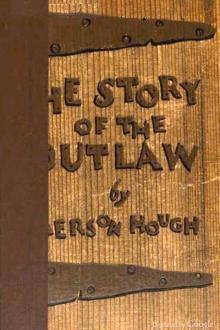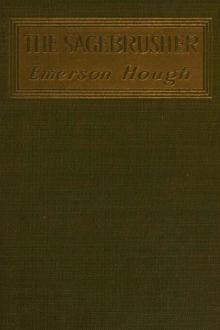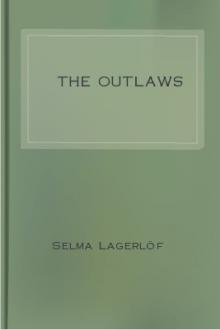The Story of the Outlaw, Emerson Hough [ereader that reads to you txt] 📗

- Author: Emerson Hough
- Performer: -
Book online «The Story of the Outlaw, Emerson Hough [ereader that reads to you txt] 📗». Author Emerson Hough
"The murder of Sheriff Cross occurred in 1888. The militia were withdrawn within about thirty days thereafter. Both towns continued to break the law—in short, agreed jointly to break the law. They drew up a stipulation, it is said, under which Colonel Wood was to have all the charges against the Hugoton men dismissed. In return, Wood was to have all the charges against him in Hugoton dismissed, and was to have safe conduct when he came up to court. Not even this compounding of felony was kept as a pact between these treacherous communities.
"The trial lagged. Wood was once more under bond to appear at Hugoton, before the court of his enemy, Judge Botkin, and among many other of his Hugoton enemies. On the day that Colonel Wood was to go for his trial, June 23, 1891, he drove up in a buggy. In the vehicle with him were his wife and a Mrs. Perry Carpenter. Court was held in the Methodist church. At the time of Wood's arrival, the docket had been called and a number of cases set for trial, including one against Wood for arson—there was no crime in the calendar of which one town did not accuse the other, and, indeed, of which the citizens of either were not guilty.
"Wood left the two ladies sitting in the buggy, near the door, and stepped up to the clerk's desk to look over some papers. As he went in, he passed, leaning against the door, one Jim Brennan, a deputy of Hugoton, who did not seem to notice him. Brennan was a friend of C. E. Cook, then under conviction for the Hay Meadows massacre. Brennan stood talking to Mrs. Wood and Mrs. Carpenter, smiling and apparently pleasant. Colonel Wood turned and came down towards the door, again passing close to Brennan but not speaking to him. He was almost upon the point of climbing to his seat in the buggy, when Brennan, without a word and without any sort of warning, drew a revolver and shot him in the back. Wood wheeled around, and Brennan shot him the second time, through the right side. Not a word had been spoken by any one. Wood now started to run around the corner of the house. His wife, realizing now what was happening, sprang from the buggy-seat and followed to protect him. Brennan fired a third time, but missed. Mrs. Wood, reaching her husband's side, threw her arms around his neck. Brennan coming close up, fired a fourth shot, this time through Wood's head. The murdered man fell heavily, literally in his wife's arms, and for the moment it was thought both were killed. Brennan drew a second revolver, and so stood over Wood's corpse, refusing to surrender to any one but the sheriff of Morton county.
"The presiding judge at this trial was Theodosius Botkin, a figure of peculiar eminence in Kansas at that time. Botkin gave Brennan into the custody of the sheriff of Morton county. He was removed from the county, and it need hardly be stated that when he was at last brought back for trial it was found impossible to empanel a jury, and he was set free. No one was ever punished for this cold-blooded murder.
"Colonel S. N. Wood was an Ohio man, but moved to Kansas in the early Free Soil days. He was a friend and champion of old John Brown and a colonel of volunteers in the civil war. He had served in the legislature of Kansas, and was a good type of the early and adventurous pioneer.
"Whether or not suspicion attached to Judge Botkin for his conduct in this matter, he himself seems to have feared revenge, for he held court with a Winchester at his hand and a brace of revolvers on the desk in front of him, his court-house always surrounded with an armed guard. He offended men in Seward county, and there was a plot made to kill him. A party lay in wait along the road to intercept Botkin on his journey from his homestead—every one in Kansas at that time had a 'claim'—but Botkin was warned by some friend. He sent out Sam Dunn, sheriff of Seward county, to discover the truth of the rumor. Dunn went on down the trail and, in a rough part of the country, was fired upon and killed, instead of Botkin. Arrests were made in this matter also, but the sham trials resulted much as had that of Brennan. The records of these trials may be seen in Seward county. It was murder for murder, anarchy for anarchy, evasion for evasion, in this portion of the frontier. Judge Botkin soon after this resigned his seat upon the bench and went to lecturing upon the virtues of the Keeley cure. Afterwards he went to the legislature—the same legislature which had once tried him on charges of impeachment as a judge!
"These events all became known in time, and lawlessness proved its own inability to endure. The towns were abandoned. Where in 1889 there were perhaps 4,000 people, there remained not 100. The best of the farms were abandoned or sold for taxes, the late inhabitants of the two warring settlements wandering out over the world. The legislature, hoodwinked or cajoled heretofore, at length disorganized the county, and anarchy gave back its own to the wilderness.
"I have indicated that the trial of the men guilty of assassinating my friends and of attempting to kill myself in the Hay Meadow butchery was one which reached a considerable importance at the time. The crimes were committed in that strange portion of the country called No Man's Land or the Neutral Strip. The accused were tried in the United States court at Paris, Texas. I myself drew the indictments against them. There were tried the Cooks, Chamberlain, Robinson and others of the Hugoton party, and of these six were convicted and sentenced to be hung. These men were defended by Colonel George R. Peck, later chief counsel of the Chicago, Milwaukee & St. Paul Railway. With him were associated Judge John F. Dillon, of New York; W. H. Rossington, of St. Louis; Senator Manderson, of Nebraska; Colonel Robert G. Ingersoll, and others. The Knights of Pythias raised a fund to defend the prisoners, and spent perhaps a hundred thousand dollars in all in this undertaking. A vast political 'pull' was exercised at Topeka and Washington. After the sentence had been passed, the case was taken up to the United States Supreme Court, on the ground that the Texas court had no jurisdiction in the premises, and on the further grounds of errors in the trial. The United States Supreme Court, in 1891, reversed the Texas court, on an error on the admission of evidence, and remanded the cases. The men were never put on trial again, except that, in 1898, Sam Robinson, meantime pardoned out of the penitentiary in Colorado, where he had been sent for robbing the United States mails at Florissant, Colorado, returned to Texas, and was arrested on the old charge. The men convicted were C. E. Cook, Orrin Cook, Cyrus C. Freese, John Lawrence and John Jackson.
"The Illinois legislature petitioned Congress to extend United States jurisdiction over No Man's Land, and so did the state of Indiana; and it was attached to the East District of Texas for the purposes of jurisdiction. Congressman Springer held up this bill for a time, using it as a club for the passage of a measure of his own upon which he was intent. Thus, it may be seen that the tawdry little tragedy in that land which indeed was 'No Man's Land' in time attained a national prominence.
"The collecting of the witnesses for this trial cost the United States government over one hundred thousand dollars. The trial was long and bitterly fought. It resulted, as did every attempt to convict those concerned in the bloody doings of Stevens county, in an absolute failure of the ends of justice. Of all the murders committed in that bitter fighting, not one murderer has ever been punished! Never was greater political or judicial mockery.
"I had the singular experience, once in my life, of eating dinner at the same table with the man who brutally shot me down and left me for dead. J. B. Chamberlain, the man who shot me, and who thought he had killed me, came in with a friend and sat down at the same table in a Leavenworth, Kansas, restaurant, where I was eating. My opportunity for revenge was there. I did not take it. Chamberlain and his friend did not know who I was. I left the matter to the law, with what results the records of the law's failure in these matters has shown.
"Of those who were tried for these murders, J. B. Chamberlain is now dead. C. E. Cook, who was much alarmed lest the cases might be reinstated in the year 1898, claims Quincy, Illinois, as his home, but has interests in Florida. O. J. Cook is dead. Jack Lawrence is dead. John Kelley is dead. Other actors in the drama, unconvicted, are also dead or nameless wanderers. As the indictments were all quashed in 1898, Sam Robinson, whose whereabouts is unknown, will never be brought to trial for his deeds in the Hay Meadow butchery. He was not tried at Paris, being then in the Colorado penitentiary. His friend and partner, Bert Nobel, who was sent to the penitentiary for seven years for participating in the postoffice robbery, was pardoned out, and later killed a policeman at Trinidad, Colorado. He was tried there and hanged. So far as I know, this is the only legal punishment ever inflicted upon any of the Hugoton or Woodsdale men, who outvied each other in a lawlessness for which anarchy would be a mild name."
Chapter XVIBiographies of Bad Men—Desperadoes of the Deserts—Billy the Kid, Jesse Evans, Joel Fowler, and Others Skilled in the Art of Gun Fighting.
The desert regions of the West seemed always to breed truculence and touchiness. Some of the most desperate outlaws have been those of western Texas, New Mexico, and Arizona. These have sometimes been Mexicans, sometimes half-breed Indians, very rarely full-blood or half-blood negroes. The latter race breeds criminals, but lacks in the initiative required in the character of the desperado. Texas and the great arid regions west of Texas produced rather more than their full quota of bad white men who took naturally to the gun.
By all means the most prominent figure in the general fighting along the Southwestern border, which found climax in the Lincoln County War, was that historic and somewhat romantic character known as Billy the Kid, who had more than a score of killings to his credit at the time of his death at the age of twenty-one. His character may not be





Comments (0)